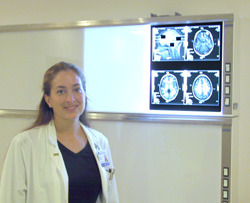A central focus of medical education at Duke University is clinical research. To encourage their development as physician-scientists, third-year medical students conduct research projects in a laboratory at Duke Medical Center. BIAC has limited openings each year for outstanding medical students. These students will work closely with BIAC faculty on projects using functional neuroimaging or electrophysiological techniques to study the brain.

BIAC provides an excellent environment for medical students at Duke University to conduct independent research. BIAC faculty are supportive of medical student research. Students are encouraged to develop projects that contribute to clinical or basic science through publication and/or presentation at academic conferences. Typically, 2-3 medical students study at BIAC each year, so students learn from their peers while doing research. In addition, many post-doctoral fellows, graduate students, and research assistants work in BIAC, providing both a strong academic culture and a valuable resource for answering research questions.
What are the areas of interest of BIAC faculty members?
BIAC faculty members pursue research in many aspects of neuroimaging. Faculty members study cognitive processes such as attention and memory, neuroimaging methods, brain changes accompanying neurological disorders, and other topics.
What are some potential sources of funding for medical students who pursue research in the lab?
The lab receives funding from the Howard Hughes Medical Institute and students can apply for a fellowship from that organization. Other possible avenues of funding include the National Institute of Health (NIH), the American Society of Neuroradiology (ASNR), and the American Roentgen Ray Society (ARRS).
What types of projects have medical students have conducted at BIAC?
Recent projects have included studies of semantic priming, neural representations of number judgments, the effects of aging on the brain, and facial recognition in Alzheimer's Disease.
How will BIAC prepare me for a career in academic medicine?
BIAC faculty members are committed to providing medical students with an opportunity to conduct high-quality original research. An important component of this commitment is direct contact with BIAC faculty. Medical students attend faculty lab meetings and BIAC seminar series, and work with other students in a common laboratory. Faculty members are directly involved with supervision of the medical student projects. In addition, students may have the opportunity to present their research at academic conferences, such as the meetings of the Society for Neuroscience or the Cognitive Neuroscience Society, or to submit their research to an academic journal. In 2000-2001, J.C. Leveque, who conducted research at BIAC with Dr. Gregory McCarthy, received the Talmadge Peele Award for outstanding research in neurobiology by a third-year medical student.
How can I arrange to work with someone at BIAC?
Contact the main office or a BIAC faculty member in your area of interest.
